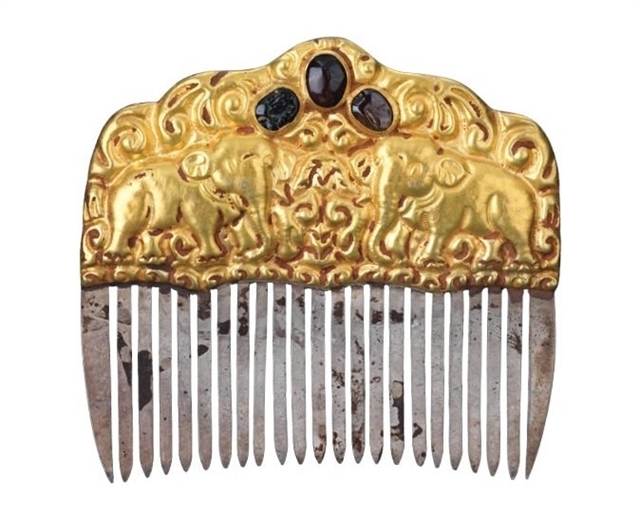The exhibition features over 60 artefacts crafted from gold and silver during the 17th to 18th centuries. Many of these remarkable objects are on public display for the first time.
HÀ NỘI — Dozens of precious antique artefacts are on display in a temporary exhibition at the Việt Nam National Museum of History in Hà Nội.
Entitled Báu Vật Champa – Dấu Ấn Thời Gian (Champa Treasures – The Marks of Time), the exhibition features over 60 precious items, crafted from gold and silver, during the 17th to 18th centuries. Many of these remarkable objects are on public display for the first time.

A gold statue of the elephant-headed God Ganesha. — Photo courtesy of Việt Nam National Museum of History
Champa, an ancient kingdom that thrived from 192 to 1832, once occupied the region which is now central Việt Nam. Its rich cultural heritage was shaped by a captivating blend of Indian and Javanese influences, interwoven with unique Champa creations. Among its artistic achievements, three distinct styles stand out, including Mỹ Sơn, Đồng Dương, Tháp Mẫm.
Numerous temple ruins and sculptural remnants endure to this day, serving as tangible evidence that both Hinduism and Buddhism held sway as the primary religions in the ancient kingdom.

A headwear features flower petals. Photo courtesy of Việt Nam National Museum of History
Champa experienced its zenith during the 9th and 10th centuries. However, after the 15th century, as time marched forward, a gradual southward shift occurred in the heart of the Champa kingdom, accompanied by transformative changes.
Notably, from 1692 (when Lord Nguyễn established Thuận Thành Town within Champa’s territory) until 1832 (when Champa officially merged into Đại Nam, an ancient name of the current Việt Nam) under Emperor Minh Mạng, scholarly attention toward Champa’s historical, cultural and artistic aspects remained relatively limited.
That’s the reason why the Museum of History has collaborated with the Việt Nam Cultural Heritage Association and antique collector Đào Danh Đức to select more than 60 typical artefacts from this historical period to introduce to the public.
The exhibition is divided into two sections – one showcasing religious statues and sacred antiquities and the other highlighting jewellery and items imbued with both religious significance and royal authority.

A gold necklace features God Shiva. 1 Photo courtesy of Việt Nam National Museum of History
In the first part of the exhibition, visitors will encounter a captivating array of statues depicting the God Shiva, the elephant-headed God Ganesha, the serene Buddha, the compassionate Bodhisattva Avalokitesvara, as well as the sacred linga, yoni and kosa linga – all crafted from gold and silver adorned with precious gemstones.
The second section unveils a dazzling array of Champa jewellery and regal artifacts.
Among these treasures are earrings, rings, necklaces, hairpins, combs, bracelets, and belts. Notably, these pieces bear intricate symbols rooted in Champa’s religious and traditional beliefs. Hindu deities – Brahma, Vishnu, Shiva, Ganesha – take centre stage, alongside revered creatures like the sacred bull Nandin, the divine bird Garuda and the serpent god Naga.

A comb crafted from gold, silver and gemstones. — Photo courtesy of Việt Nam National Museum of History
The National Museum of History presents this exhibition with a dual purpose – to allow both local and foreign visitors to marvel at precious historical, cultural and artistic pieces from Champa’s lesser-known past – and to deepen their understanding of this rich heritage.
The exhibition opens to public until the end of October 2024. — VNS